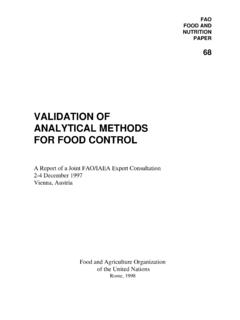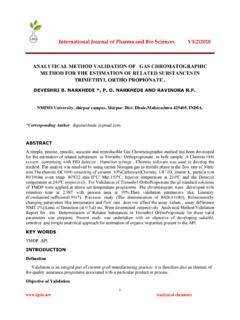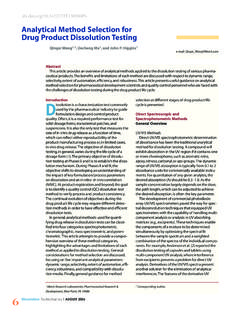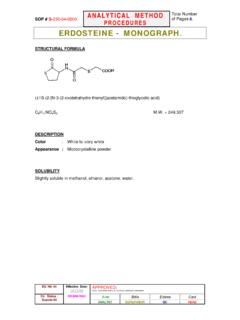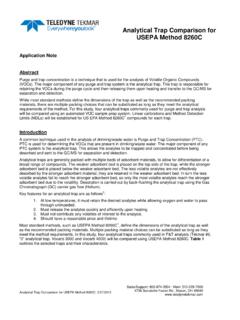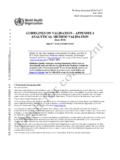Transcription of BROMINE 6011 See CHLORINE, Method 6011, for …
1 BROMINE 6011 See chlorine , Method 6011, for procedure Br2MW: : 7726-95-6 RTECS: EF9100000 Method : 6011, Issue 2 EVALUATION: FULLI ssue 1: 15 May 1989 Issue 2: 15 August 1994 OSHA ppm; STEL ppm; STEL ppm(1 ppm = mg/m3)PROPERTIES:liquid; d g/mL @ 20 C;BP C; VP kPa (175 mm Hg)@ 20 C vapor density (air=1) :PREFILTER + FILTER(PTFE, m + silver membrane,25-mm, m)FLOW to 1 L/minVOL-MIN: 8 L @ ppm-MAX:360 LSHIPMENT:routine, protect from lightSAMPLE STABILITY: 30 days at 25 C [1]BLANKS:2 to 10 field blanks per setMEASUREMENTTECHNIQUE:ION CHROMATOGRAPHY, CONDUCTIVITYANALYTE:bromide ion (Br-)EXTRACTION:3 mL 6 mM Na2S203, 10 min INJECTION VOLUME:50 LCOLUMN:Dionex HPIC-AG4A guard, HPIC-AS4 Aseparator, MFC-1 precolumn, AMMS anion suppressorDETECTOR SETTING:10 S full mM NaHCO3/4 mMNa2CO3 mM p-cyanophenol, 2 mL/minCALIBRATION:standard solutions of Br- indeionized waterRANGE:5 to 150 g Br- per sample [1]ESTIMATED g Br- per sample [1]PRECISION (S r) @ 5 to 100 g per sample [1]ACCURACYRANGE to mg/m3(72-L samples)BIAS:- PRECISION (S rT) [1]ACCURACY.
2 The working ranges for Br2 and Cl2 are to ppm ( to mg/m3) and to ppm ( mg/m3) respectively for a 90-L air sample. The Method has sufficient sensitivity for STEL : Hydrogen sulfide gives a negative interference. HCl gives a positive interference upon a maximum of 15 gper sample. HBr gives a positive interference as it is sampled continuously [1].OTHER methods : P&CAM 209 (colorimetric) [2], OSHA methods ID-101 [3] and ID-108 [4] are alternative Manual of Analytical methods (NMAM), Fourth Edition, 8/15/94 chlorine 6011 Cl2MW: : 7782-50-5 RTECS: FO2100000 Method : 6011, Issue 2 EVALUATION: FULLI ssue 1: 15 May 1989 Issue 2: 15 August 1994 OSHA :C 1 ppm; STEL 1 ppm; STEL 1 ppm(1 ppm = mg/m3 @ NTP)PROPERTIES:gas; d g/L at 0 C; BP C;vapor density (air = 1) :PREFILTER + FILTER(PTFE, m + silver membrane,25-mm, m)FLOW to 1 L/minVOL-MIN: 2 L @ ppm-MAX:90 LSHIPMENT:routine, protect from lightSAMPLE STABILITY: 30 days at 25 C [1]BLANKS:2 to 10 field blanks per setMEASUREMENTTECHNIQUE:ION CHROMATOGRAPHY, CONDUCTIVITYANALYTE:chloride ion (Cl-) or bromide ion (Br-)EXTRACTION:3 mL 6 mM Na2S203, 10 min INJECTION VOLUME:50 LCOLUMN:Dionex HPIC-AG4A guard, HPIC-AS4 Aseparator MFC-1 precolumn, AMMS anionsuppressorDETECTOR SETTING:10 S full mM NaHCO3/4 mM Na2CO3 p-cyanophenol, 2 mL/minCALIBRATION:standard solutions of Cl- in deionizedwaterRANGE:2 to 50 g Cl- per sample [1]ESTIMATED g Cl- per sample [1]PRECISION (S r) @ to 100 g per sample [1]ACCURACYRANGE to mg/m3(15-L samples)BIAS:- PRECISION (S rT) [1]ACCURACY.
3 The working ranges for Br2 and Cl2 are to ppm ( to mg/m3) and to ppm ( mg/m3) respectively for a 90-L air sample. The Method has sufficient sensitivity for STEL : Hydrogen sulfide gives a negative interference. HCl gives a positive interference up to a maximum of 15 g per sample. HBr gives a positive interference as it is sampled continuously [1].OTHER methods : P&CAM 209 (colorimetric) [2], OSHA methods ID-101 [3] and ID-108 [4] are alternative Manual of Analytical methods (NMAM), Fourth Edition, 8/15/94 chlorine AND BROMINE : Method 6011, Issue 2, dated 15 August 1994 - Page 2 of 5 thiosulfate, reagent , solution: 6 mM Na2S2O3. g Na2S2O3 in 500 mL deionized : mM NaHCO3/4 mMNa2CO3 mM p-cyanophenol. g NaHCO3, g Na2CO3 g p-cyanophenol in 2 L filtereddeionized regenerant, N H2SO4. Dilute mL conc. H2SO4 to 4 L withdeionized water.* stock solutions, 1 mg/mL (asanion).
4 (1)Dissolve g KBr in 100 mLdeionized water(2)Dissolve g KCl in 100 mL deionizedwater.*See SPECIAL : : Silver membrane filter,* 25-mm, m, (Costar/Nuclepore, Poretics, orequivalent) with porous plastic support pad(Costar/Nuclepore); prefilter, PTFE with PTFE support, m (Gelman Zefluor, SKC, orequivalent), or polyester, m(Costar/Nuclepore) with porous plastic supportpad; three-piece, 25-mm carbon-filledpolypropylene cassette (opaque) with 50-mmextension (Costar/Nuclepore or Gelman)(Fig. 1). the outlet piece of cassette, placeporous plastic support pad and cleanedsilver filter. Insert 50-mm extension (cowl) the inlet (top) of the extension, placeporous plastic support pad and inlet cassette piece each connection with shrinkablebands or tape. sampling pump, to 1 L/min, withflexible connecting tubing. chromatograph with Dionex MFC-1, HPIC-AG4A, HPIC-AS4A columns, AMMS anionmicromembrane suppressor, conductivitydetector and integrator (page 6011-1).
5 , 30-mL, wide mouth with screw caps,amber or opaque polyethylene. , with disposable tips. flasks, 10- and 100-mL. reagent dispensers, 0 to 10-mL. , 10-mL, polyethylene, luer-tip. *Silver membrane filters must be cleanedprior to use (see APPENDIX A).NOTE:Some lots of silver membranefilters contain excessively highchloride background screen before field PRECAUTIONS: Sulfuric acid is extremely corrosive to skin, eyes, and mucous protective clothing. Handle in a fume each personal sampling pump with a representative sampler in sampler to personal sampling pump with flexible at an accurately known flow rate between and 1 L/min for a total sample size of 8 to360 L for BROMINE or 2 to 90 L for ends of sampler with plugs. Pack securely for Manual of Analytical methods (NMAM), Fourth Edition, 8/15/94 chlorine AND BROMINE : Method 6011, Issue 2, dated 15 August 1994 - Page 3 of 5 SAMPLE PREPARATION:NOTE:Silver halides are photosensitive.
6 Protect from light during transfer and very dim or red light, open cassette and transfer the silver filter with forceps to amberbottle. Add 3 mL 6 mM Na2S2O3 and :Prefilter may be analyzed for particulate halides, or samples to stand a minimum of 10 min with occasional : Once desorbed, samples are no longer the sample bottles and add 7 mL deionized water for a total solution volume of 10 sample into 10-mL plastic syringe for manual injection or into autosampler AND QUALITY daily with at least six working standards covering the range of to 15 g bromideand/or to 5 g chloride per mL of known aliquots of calibration stock solution to deionized water in 10-mL volumetricflasks and dilute to the mark with deionized fresh working standards working standards together with samples and blanks (steps 11 through 13). a calibration graph (peak height vs. g of anion per sample). three quality control spikes, three analyst spikes and media blanks to ensure thatcalibration graph is in ion chromatograph according to manufacturer's instructions and to conditions given on :Excessive amounts of Ag+ and Ag(S2O3)23- deteriorate column preformance.
7 Use ametal free column (MFC-1) prior to the chromatographic columns and recondition thecolumn every 100 to 150 analyses (See APPENDIX B). 50- L sample aliquot manually or with autosampler. For manual operation, inject 2 to 3mL of sample from syringe to ensure complete rinse of the sample peak height. If sample peak height exceeds linear calibration range, dilute withdeionized water, reanalyze, and apply the appropriate dilution factor in the the calibration graph, determine the mass of Br- or Cl- in each sample, W ( g), and in theaverage blank, B ( g). the concentration, C (mg/m3), of Br2 or Cl2 in the air volume sampled, V (L):EVALUATION OF Method :The Method was evaluated by sampling generated atmospheres of Br2 and Cl2 at both high (80%) andlow (20%) relative humidities [1]. Samples were taken at four concentration levels ranging from mg/m3 for Br2 and to mg/m3 for Cl2. Overall recovery for Br2 was with totaloverall precision, S rT, of Overall recovery for Cl2 was with total overall precision, S rT, Samples for Cl2 were stable at least 30 days at 25 C (103 4% Recovery) and up to 60 days at5 C (101 3% Recovery).
8 The Br2 samples were stable up to 60 days at 25 C ( ).NIOSH Manual of Analytical methods (NMAM), Fourth Edition, 8/15/94 chlorine AND BROMINE : Method 6011, Issue 2, dated 15 August 1994 - Page 4 of 5 REFERENCES:[1]Cassinelli, Development of Solid Sorbent Monitoring Method for chlorine and Brominewith Determination by Ion Chromatography, Appl. Occup. Environ. Hyg., 6:215-226 (1991).[2]NIOSH Manual of Analytical methods , 2nd ed.; Taylor, , Ed.; V. 1, P of Health Education and Welfare, Public Health Service, Centers for DiseaseControl, National Institute for Occupational Safety and Health; DHEW (NIOSH) Publication , 1977.[3]Occupational Safety and Health Administration Analytical Laboratory: OSHA Analytical MethodsManual, Method No. ID-101). American Conference of Governmental Industrial Hygienists: Cincinnati, OH, 1985; Publ. No. ISBN: 0-936712-66-X.[4]Occupational Safety and Health Administration Analytical Laboratory: OSHA Analytical MethodsManual, ( Method No.
9 ID-108). American Conference of Governmental Industrial Hygienists:Cincinnati, OH, 1985; Publ. No. ISBN: WRITTEN BY: Mary Ellen Cassinelli, NIOSH/DPSEAPPENDIX A: CLEANING PROCEDURE FOR SILVER MEMBRANE FILTERSNOTE:Some lots of silver membrane filters contain extremely high chloride background levels. Ifexcessively high this cleaning procedure will not remove all of the chloride, even if repeatedseveral times. Screening is necessary for each lot before being used for this Method . Screening may be done by following this procedure at least twice, or by analyzing by each filter in a 30-mL, wide-mouth bottle, and add 3 mL 6 mM to stand for a minimum of 10 min with occasional solution and rinse thoroughly with deionized water. Allow the filters to stand in last rinse fora few filters from bottles and dry between layers of absorbent laboratory cleaned filters between paper disks in manufacturer's container.
10 Filters are stable for at least8 B: COLUMN RECONDITIONING PROCEDUREIn the following order, pump through the analytical columns at 2 mL/ mL deionized water to rinse; mL 1 M HNO3 to remove contaminants; mL M Na2CO3 to remove the NO3-; to is recomended after 100 to 150 Manual of Analytical methods (NMAM), Fourth Edition, 8/15/94 chlorine AND BROMINE : Method 6011, Issue 2, dated 15 August 1994 - Page 5 of 5 Figure 1. Silver Filter SamplerNIOSH Manual of Analytical methods (NMAM), Fourth Edition, 8/15/94










